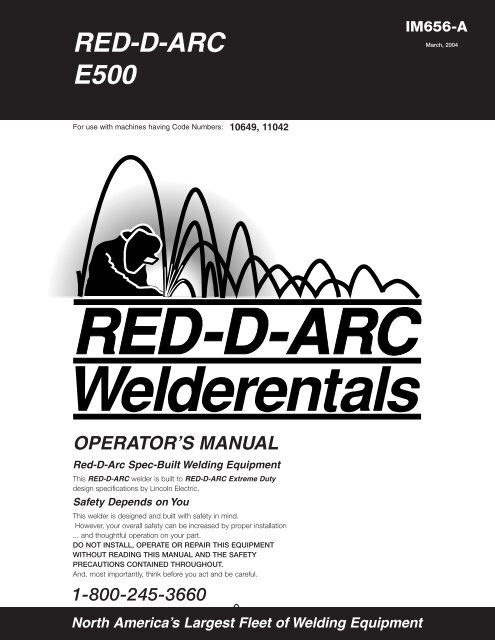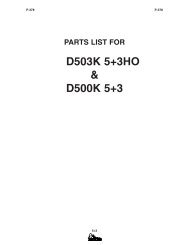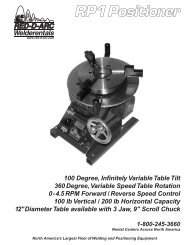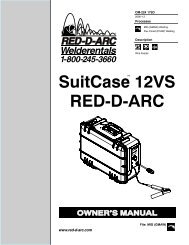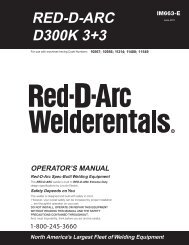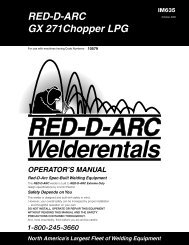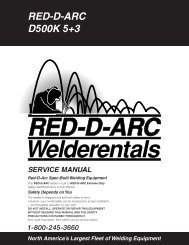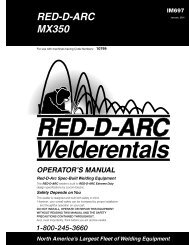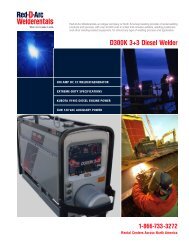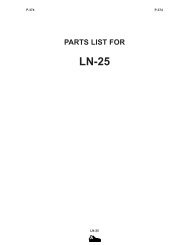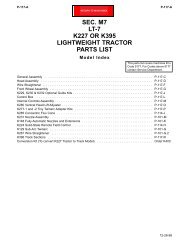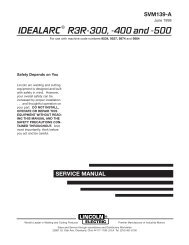RED-D-ARC E500
RED-D-ARC E500
RED-D-ARC E500
Create successful ePaper yourself
Turn your PDF publications into a flip-book with our unique Google optimized e-Paper software.
<strong>RED</strong>-D-<strong>ARC</strong><br />
<strong>E500</strong><br />
IM656-A<br />
March, 2004<br />
For use with machines having Code Numbers: 10649, 11042<br />
OPERATOR’S MANUAL<br />
Red-D-Arc Spec-Built Welding Equipment<br />
This <strong>RED</strong>-D-<strong>ARC</strong> welder is built to <strong>RED</strong>-D-<strong>ARC</strong> Extreme Duty<br />
design specifications by Lincoln Electric.<br />
Safety Depends on You<br />
This welder is designed and built with safety in mind.<br />
However, your overall safety can be increased by proper installation<br />
... and thoughtful operation on your part.<br />
DO NOT INSTALL, OPERATE OR REPAIR THIS EQUIPMENT<br />
WITHOUT READING THIS MANUAL AND THE SAFETY<br />
PRECAUTIONS CONTAINED THROUGHOUT.<br />
And, most importantly, think before you act and be careful.<br />
1-800-245-3660<br />
North America’s Largest Fleet of Welding Equipment
i<br />
Diesel engine exhaust and some of its constituents<br />
are known to the State of California to cause cancer,<br />
birth defects, and other reproductive harm.<br />
The Above For Diesel Engines<br />
FOR ENGINE<br />
powered equipment.<br />
1.a. Turn the engine off before troubleshooting and maintenance<br />
work unless the maintenance work requires it to be running.<br />
____________________________________________________<br />
1.b.Operate engines in open, well-ventilated<br />
areas or vent the engine exhaust fumes<br />
outdoors.<br />
____________________________________________________<br />
1.c. Do not add the fuel near an open flame welding<br />
arc or when the engine is running. Stop<br />
the engine and allow it to cool before refueling<br />
to prevent spilled fuel from vaporizing on<br />
contact with hot engine parts and igniting. Do<br />
not spill fuel when filling tank. If fuel is spilled,<br />
wipe it up and do not start engine until fumes<br />
have been eliminated.<br />
____________________________________________________<br />
1.d. Keep all equipment safety guards, covers<br />
and devices in position and in good<br />
repair.Keep hands, hair, clothing and tools<br />
away from V-belts, gears, fans and all other<br />
moving parts when starting, operating or<br />
repairing equipment.<br />
____________________________________________________<br />
1.e. In some cases it may be necessary to remove safety<br />
guards to perform required maintenance. Remove<br />
guards only when necessary and replace them when the<br />
maintenance requiring their removal is complete.<br />
Always use the greatest care when working near moving<br />
parts.<br />
___________________________________________________<br />
1.f. Do not put your hands near the engine fan. Do not attempt to<br />
override the governor or idler by pushing on the throttle control<br />
rods while the engine is running.<br />
___________________________________________________<br />
1.g. To prevent accidentally starting gasoline engines while<br />
turning the engine or welding generator during maintenance<br />
work, disconnect the spark plug wires, distributor cap or<br />
magneto wire as appropriate.<br />
SAFETY<br />
WARNING<br />
CALIFORNIA PROPOSITION 65 WARNINGS<br />
The engine exhaust from this product contains<br />
chemicals known to the State of California to cause<br />
cancer, birth defects, or other reproductive harm.<br />
The Above For Gasoline Engines<br />
<strong>ARC</strong> WELDING CAN BE HAZARDOUS. PROTECT YOURSELF AND OTHERS FROM POSSIBLE SERIOUS INJURY OR DEATH.<br />
KEEP CHILDREN AWAY. PACEMAKER WEARERS SHOULD CONSULT WITH THEIR DOCTOR BEFORE OPERATING.<br />
Read and understand the following safety highlights. For additional safety information, it is strongly recommended that you<br />
purchase a copy of “Safety in Welding & Cutting - ANSI Standard Z49.1” from the American Welding Society, P.O. Box 351040,<br />
Miami, Florida 33135 or CSA Standard W117.2-1974. A Free copy of “Arc Welding Safety” booklet E205 is available from the<br />
Lincoln Electric Company, 22801 St. Clair Avenue, Cleveland, Ohio 44117-1199.<br />
BE SURE THAT ALL INSTALLATION, OPERATION, MAINTENANCE AND REPAIR PROCEDURES ARE<br />
PERFORMED ONLY BY QUALIFIED INDIVIDUALS.<br />
Mar ‘95<br />
1.h. To avoid scalding, do not remove the<br />
radiator pressure cap when the engine is<br />
hot.<br />
ELECTRIC AND<br />
MAGNETIC FIELDS<br />
may be dangerous<br />
2.a. Electric current flowing through any conductor causes<br />
localized Electric and Magnetic Fields (EMF). Welding<br />
current creates EMF fields around welding cables and<br />
welding machines<br />
2.b. EMF fields may interfere with some pacemakers, and<br />
welders having a pacemaker should consult their physician<br />
before welding.<br />
2.c. Exposure to EMF fields in welding may have other health<br />
effects which are now not known.<br />
2.d. All welders should use the following procedures in order to<br />
minimize exposure to EMF fields from the welding circuit:<br />
2.d.1. Route the electrode and work cables together - Secure<br />
them with tape when possible.<br />
2.d.2. Never coil the electrode lead around your body.<br />
2.d.3. Do not place your body between the electrode and<br />
work cables. If the electrode cable is on your right<br />
side, the work cable should also be on your right side.<br />
2.d.4. Connect the work cable to the workpiece as close as<br />
possible to the area being welded.<br />
2.d.5. Do not work next to welding power source.<br />
i<br />
<strong>E500</strong>
ii<br />
ELECTRIC SHOCK can kill.<br />
3.a. The electrode and work (or ground) circuits<br />
are electrically “hot” when the welder is on.<br />
Do not touch these “hot” parts with your bare<br />
skin or wet clothing. Wear dry, hole-free<br />
gloves to insulate hands.<br />
SAFETY<br />
<strong>ARC</strong> RAYS can burn.<br />
4.a. Use a shield with the proper filter and cover<br />
plates to protect your eyes from sparks and<br />
the rays of the arc when welding or observing<br />
open arc welding. Headshield and filter lens<br />
should conform to ANSI Z87. I standards.<br />
ii<br />
3.b. Insulate yourself from work and ground using dry insulation.<br />
Make certain the insulation is large enough to cover your full<br />
area of physical contact with work and ground.<br />
In addition to the normal safety precautions, if welding<br />
must be performed under electrically hazardous<br />
conditions (in damp locations or while wearing wet<br />
clothing; on metal structures such as floors, gratings or<br />
scaffolds; when in cramped positions such as sitting,<br />
kneeling or lying, if there is a high risk of unavoidable or<br />
accidental contact with the workpiece or ground) use<br />
the following equipment:<br />
• Semiautomatic DC Constant Voltage (Wire) Welder.<br />
• DC Manual (Stick) Welder.<br />
• AC Welder with Reduced Voltage Control.<br />
3.c. In semiautomatic or automatic wire welding, the electrode,<br />
electrode reel, welding head, nozzle or semiautomatic<br />
welding gun are also electrically “hot”.<br />
3.d. Always be sure the work cable makes a good electrical<br />
connection with the metal being welded. The connection<br />
should be as close as possible to the area being welded.<br />
3.e. Ground the work or metal to be welded to a good electrical<br />
(earth) ground.<br />
3.f.<br />
Maintain the electrode holder, work clamp, welding cable and<br />
welding machine in good, safe operating condition. Replace<br />
damaged insulation.<br />
3.g. Never dip the electrode in water for cooling.<br />
3.h. Never simultaneously touch electrically “hot” parts of<br />
electrode holders connected to two welders because voltage<br />
between the two can be the total of the open circuit voltage<br />
of both welders.<br />
3.i.<br />
When working above floor level, use a safety belt to protect<br />
yourself from a fall should you get a shock.<br />
3.j. Also see Items 6.c. and 8.<br />
4.b. Use suitable clothing made from durable flame-resistant<br />
material to protect your skin and that of your helpers from<br />
the arc rays.<br />
4.c. Protect other nearby personnel with suitable, non-flammable<br />
screening and/or warn them not to watch the arc nor expose<br />
themselves to the arc rays or to hot spatter or metal.<br />
FUMES AND GASES<br />
can be dangerous.<br />
5.a. Welding may produce fumes and gases<br />
hazardous to health. Avoid breathing these<br />
fumes and gases.When welding, keep<br />
your head out of the fume. Use enough<br />
ventilation and/or exhaust at the arc to keep<br />
fumes and gases away from the breathing zone. When<br />
welding with electrodes which require special<br />
ventilation such as stainless or hard facing (see<br />
instructions on container or MSDS) or on lead or<br />
cadmium plated steel and other metals or coatings<br />
which produce highly toxic fumes, keep exposure as<br />
low as possible and below Threshold Limit Values (TLV)<br />
using local exhaust or mechanical ventilation. In<br />
confined spaces or in some circumstances, outdoors, a<br />
respirator may be required. Additional precautions are<br />
also required when welding on galvanized steel.<br />
5.b. Do not weld in locations near chlorinated hydrocarbon vapors<br />
coming from degreasing, cleaning or spraying operations.<br />
The heat and rays of the arc can react with solvent vapors to<br />
form phosgene, a highly toxic gas, and other irritating<br />
products.<br />
5.c. Shielding gases used for arc welding can displace air and<br />
cause injury or death. Always use enough ventilation,<br />
especially in confined areas, to insure breathing air is safe.<br />
5.d. Read and understand the manufacturer’s instructions for this<br />
equipment and the consumables to be used, including the<br />
material safety data sheet (MSDS) and follow your<br />
employer’s safety practices. MSDS forms are available from<br />
your welding distributor or from the manufacturer.<br />
5.e. Also see item 1.b.<br />
Mar ‘95<br />
<strong>E500</strong>
iii<br />
SAFETY<br />
iii<br />
WELDING SPARKS can<br />
cause fire or explosion.<br />
6.a. Remove fire hazards from the welding area.<br />
If this is not possible, cover them to prevent<br />
the welding sparks from starting a fire.<br />
Remember that welding sparks and hot<br />
materials from welding can easily go through small cracks<br />
and openings to adjacent areas. Avoid welding near<br />
hydraulic lines. Have a fire extinguisher readily available.<br />
6.b. Where compressed gases are to be used at the job site,<br />
special precautions should be used to prevent hazardous<br />
situations. Refer to “Safety in Welding and Cutting” (ANSI<br />
Standard Z49.1) and the operating information for the<br />
equipment being used.<br />
6.c. When not welding, make certain no part of the electrode<br />
circuit is touching the work or ground. Accidental contact can<br />
cause overheating and create a fire hazard.<br />
6.d. Do not heat, cut or weld tanks, drums or containers until the<br />
proper steps have been taken to insure that such procedures<br />
will not cause flammable or toxic vapors from substances<br />
inside. They can cause an explosion even though they have<br />
been “cleaned”. For information, purchase “Recommended<br />
Safe Practices for the Preparation for Welding and Cutting of<br />
Containers and Piping That Have Held Hazardous<br />
Substances”, AWS F4.1 from the American Welding Society<br />
(see address above).<br />
6.e. Vent hollow castings or containers before heating, cutting or<br />
welding. They may explode.<br />
6.f. Sparks and spatter are thrown from the welding arc. Wear oil<br />
free protective garments such as leather gloves, heavy shirt,<br />
cuffless trousers, high shoes and a cap over your hair. Wear<br />
ear plugs when welding out of position or in confined places.<br />
Always wear safety glasses with side shields when in a<br />
welding area.<br />
6.g. Connect the work cable to the work as close to the welding<br />
area as practical. Work cables connected to the building<br />
framework or other locations away from the welding area<br />
increase the possibility of the welding current passing<br />
through lifting chains, crane cables or other alternate circuits.<br />
This can create fire hazards or overheat lifting chains or<br />
cables until they fail.<br />
6.h. Also see item 1.c.<br />
CYLINDER may explode<br />
if damaged.<br />
7.a. Use only compressed gas cylinders<br />
containing the correct shielding gas for the<br />
process used and properly operating<br />
regulators designed for the gas and<br />
pressure used. All hoses, fittings, etc. should be suitable for<br />
the application and maintained in good condition.<br />
7.b. Always keep cylinders in an upright position securely<br />
chained to an undercarriage or fixed support.<br />
7.c. Cylinders should be located:<br />
• Away from areas where they may be struck or subjected to<br />
physical damage.<br />
• A safe distance from arc welding or cutting operations and<br />
any other source of heat, sparks, or flame.<br />
7.d. Never allow the electrode, electrode holder or any other<br />
electrically “hot” parts to touch a cylinder.<br />
7.e. Keep your head and face away from the cylinder valve outlet<br />
when opening the cylinder valve.<br />
7.f.<br />
Valve protection caps should always be in place and hand<br />
tight except when the cylinder is in use or connected for<br />
use.<br />
7.g. Read and follow the instructions on compressed gas<br />
cylinders, associated equipment, and CGA publication P-l,<br />
“Precautions for Safe Handling of Compressed Gases in<br />
Cylinders,” available from the Compressed Gas Association<br />
1235 Jefferson Davis Highway, Arlington, VA 22202.<br />
FOR ELECTRICALLY<br />
powered equipment.<br />
8.a. Turn off input power using the disconnect<br />
switch at the fuse box before working on<br />
the equipment.<br />
8.b. Install equipment in accordance with the U.S. National<br />
Electrical Code, all local codes and the manufacturer’s<br />
recommendations.<br />
8.c. Ground the equipment in accordance with the U.S. National<br />
Electrical Code and the manufacturer’s recommendations.<br />
Mar ‘95<br />
<strong>E500</strong>
iv<br />
SAFETY<br />
iv<br />
PRÉCAUTIONS DE SÛRETÉ<br />
Pour votre propre protection lire et observer toutes les instructions<br />
et les précautions de sûreté specifiques qui parraissent dans ce<br />
manuel aussi bien que les précautions de sûreté générales suivantes:<br />
Sûreté Pour Soudage A L’Arc<br />
1. Protegez-vous contre la secousse électrique:<br />
a. Les circuits à l’électrode et à la piéce sont sous tension<br />
quand la machine à souder est en marche. Eviter toujours<br />
tout contact entre les parties sous tension et la peau nue<br />
ou les vétements mouillés. Porter des gants secs et sans<br />
trous pour isoler les mains.<br />
b. Faire trés attention de bien s’isoler de la masse quand on<br />
soude dans des endroits humides, ou sur un plancher metallique<br />
ou des grilles metalliques, principalement dans<br />
les positions assis ou couché pour lesquelles une grande<br />
partie du corps peut être en contact avec la masse.<br />
c. Maintenir le porte-électrode, la pince de masse, le câble de<br />
soudage et la machine à souder en bon et sûr état defonctionnement.<br />
d.Ne jamais plonger le porte-électrode dans l’eau pour le<br />
refroidir.<br />
e. Ne jamais toucher simultanément les parties sous tension<br />
des porte-électrodes connectés à deux machines à souder<br />
parce que la tension entre les deux pinces peut être le<br />
total de la tension à vide des deux machines.<br />
f. Si on utilise la machine à souder comme une source de<br />
courant pour soudage semi-automatique, ces precautions<br />
pour le porte-électrode s’applicuent aussi au pistolet de<br />
soudage.<br />
zones où l’on pique le laitier.<br />
6. Eloigner les matériaux inflammables ou les recouvrir afin de<br />
prévenir tout risque d’incendie dû aux étincelles.<br />
7. Quand on ne soude pas, poser la pince à une endroit isolé de<br />
la masse. Un court-circuit accidental peut provoquer un<br />
échauffement et un risque d’incendie.<br />
8. S’assurer que la masse est connectée le plus prés possible de<br />
la zone de travail qu’il est pratique de le faire. Si on place la<br />
masse sur la charpente de la construction ou d’autres endroits<br />
éloignés de la zone de travail, on augmente le risque de voir<br />
passer le courant de soudage par les chaines de levage,<br />
câbles de grue, ou autres circuits. Cela peut provoquer des<br />
risques d’incendie ou d’echauffement des chaines et des<br />
câbles jusqu’à ce qu’ils se rompent.<br />
9. Assurer une ventilation suffisante dans la zone de soudage.<br />
Ceci est particuliérement important pour le soudage de tôles<br />
galvanisées plombées, ou cadmiées ou tout autre métal qui<br />
produit des fumeés toxiques.<br />
10. Ne pas souder en présence de vapeurs de chlore provenant<br />
d’opérations de dégraissage, nettoyage ou pistolage. La<br />
chaleur ou les rayons de l’arc peuvent réagir avec les vapeurs<br />
du solvant pour produire du phosgéne (gas fortement toxique)<br />
ou autres produits irritants.<br />
11. Pour obtenir de plus amples renseignements sur la sûreté, voir<br />
le code “Code for safety in welding and cutting” CSA Standard<br />
W 117.2-1974.<br />
2. Dans le cas de travail au dessus du niveau du sol, se protéger<br />
contre les chutes dans le cas ou on recoit un choc. Ne jamais<br />
enrouler le câble-électrode autour de n’importe quelle partie<br />
du corps.<br />
3. Un coup d’arc peut être plus sévère qu’un coup de soliel,<br />
donc:<br />
a. Utiliser un bon masque avec un verre filtrant approprié<br />
ainsi qu’un verre blanc afin de se protéger les yeux du rayonnement<br />
de l’arc et des projections quand on soude ou<br />
quand on regarde l’arc.<br />
b. Porter des vêtements convenables afin de protéger la<br />
peau de soudeur et des aides contre le rayonnement de<br />
l‘arc.<br />
c. Protéger l’autre personnel travaillant à proximité au<br />
soudage à l’aide d’écrans appropriés et non-inflammables.<br />
4. Des gouttes de laitier en fusion sont émises de l’arc de<br />
soudage. Se protéger avec des vêtements de protection libres<br />
de l’huile, tels que les gants en cuir, chemise épaisse, pantalons<br />
sans revers, et chaussures montantes.<br />
5. Toujours porter des lunettes de sécurité dans la zone de<br />
soudage. Utiliser des lunettes avec écrans lateraux dans les<br />
PRÉCAUTIONS DE SÛRETÉ POUR<br />
LES MACHINES À SOUDER À<br />
TRANSFORMATEUR ET À<br />
<strong>RED</strong>RESSEUR<br />
1. Relier à la terre le chassis du poste conformement au code de<br />
l’électricité et aux recommendations du fabricant. Le dispositif<br />
de montage ou la piece à souder doit être branché à une<br />
bonne mise à la terre.<br />
2. Autant que possible, I’installation et l’entretien du poste seront<br />
effectués par un électricien qualifié.<br />
3. Avant de faires des travaux à l’interieur de poste, la debrancher<br />
à l’interrupteur à la boite de fusibles.<br />
4. Garder tous les couvercles et dispositifs de sûreté à leur<br />
place.<br />
Mar. ‘93<br />
<strong>E500</strong>
v<br />
Thank You<br />
for selecting this QUALITY product. We want you to take pride in<br />
operating this product ••• as much pride as we have in bringing this<br />
product to you!<br />
v<br />
Please Examine Carton and Equipment For Damage Immediately<br />
When this equipment is shipped, title passes to the purchaser upon receipt by the carrier. Consequently, Claims<br />
for material damaged in shipment must be made by the purchaser against the transportation company at the<br />
time the shipment is received.<br />
Please record your equipment identification information below for future reference. This information can be found<br />
on your machine nameplate.<br />
Model Name & Number _____________________________________<br />
Code & Serial Number _____________________________________<br />
Date of Purchase<br />
_____________________________________<br />
Whenever you request replacement parts for or information on this equipment always supply the information you<br />
have recorded above.<br />
Read this Operators Manual completely before attempting to use this equipment. Save this manual and keep it<br />
handy for quick reference. Pay particular attention to the safety instructions we have provided for your protection.<br />
The level of seriousness to be applied to each is explained below:<br />
WARNING<br />
This statement appears where the information must be followed exactly to avoid serious personal injury or<br />
loss of life.<br />
CAUTION<br />
This statement appears where the information must be followed to avoid minor personal injury or damage to<br />
this equipment.<br />
<strong>E500</strong>
vi<br />
TABLE OF CONTENTS<br />
vi<br />
Page<br />
Installation . . . . . . . . . . . . . . . . . . . . . . . . . . . . . . . . . . . . . . . . . . . . . . . . . . . . . . . Section A<br />
Location . . . . . . . . . . . . . . . . . . . . . . . . . . . . . . . . . . . . . . . . . . . . . . . . . . . . . . . . . . . A-1<br />
Input Wiring . . . . . . . . . . . . . . . . . . . . . . . . . . . . . . . . . . . . . . . . . . . . . . . . . . . . . . . . A-1<br />
Output Connections . . . . . . . . . . . . . . . . . . . . . . . . . . . . . . . . . . . . . . . . . . . . . . . . . . A-1<br />
Operating Instructions . . . . . . . . . . . . . . . . . . . . . . . . . . . . . . . . . . . . . . . . . . . . . Section B<br />
Maintenance . . . . . . . . . . . . . . . . . . . . . . . . . . . . . . . . . . . . . . . . . . . . . . . . . . . . . Section C<br />
Troubleshooting . . . . . . . . . . . . . . . . . . . . . . . . . . . . . . . . . . . . . . . . . . . . . . . . . . Section D<br />
Troubleshooting Procedures . . . . . . . . . . . . . . . . . . . . . . . . . . . . . . . . . . . . . . D-7 – D-10<br />
Wiring Diagrams . . . . . . . . . . . . . . . . . . . . . . . . . . . . . . . . . . . . . . . . . . . . . . . . . . Section E<br />
Parts Lists . . . . . . . . . . . . . . . . . . . . . . . . . . . . . . . . In Process (P353 Series, P66-J & -K)*<br />
* Go to www.lincolnelectric.com for the latest Parts List information.<br />
<strong>E500</strong>
A-1<br />
LOCATION<br />
WARNING<br />
FALLING EQUIPMENT can cause<br />
injury.<br />
• Do not lift this machine using lift<br />
bail if it is equipped with a heavy<br />
• accessory such as trailer or gas cylinder.<br />
• Lift only with equipment of adequate lifting<br />
capacity.<br />
• Be sure machine is stable when lifting.<br />
INSTALLATION<br />
A-1<br />
Recommended Input Wire,<br />
Ground Wire and Fuse Sizes<br />
Based on U.S. National Electrical Code.<br />
For 60 hertz, 3 phase Welders at 60% Duty Cycle.<br />
Copper Wire Size<br />
Type 75°C in Conduit<br />
Input Amps 3 Input 1 Ground Super Lag Fuse<br />
Welder Volts Input Wires Wire Size in Amps<br />
<strong>E500</strong> 230 100 4 6 150<br />
460<br />
575<br />
50<br />
40<br />
8<br />
10<br />
8<br />
10<br />
70<br />
60<br />
Install the welder in a dry location where there is a free<br />
circulation of air in through the front louvers and out the<br />
back of the case. A location which minimizes the<br />
amount of smoke and dirt drawn into the front louvers<br />
reduces the chance of dirt accumulation that can block<br />
air passages, causing overheating and nuisance shutdown<br />
of the machine.<br />
INPUT WIRING<br />
WARNING<br />
ELECTRIC SHOCK can kill.<br />
• Have an electrician install and service<br />
this equipment.<br />
• Turn the input power off at the fuse<br />
box before working on equipment.<br />
• Do not touch electrically hot parts.<br />
Welder is rated for 230/460/575V input and is shipped<br />
from the factory connected for 460V input. To change<br />
the connection, see the wiring or connection diagram<br />
pasted to the inside of the access panel in the case<br />
back.<br />
Be sure the voltage, phase and frequency of the input<br />
power is as specified on the welder nameplate.<br />
Have a qualified electrician remove the access panel in<br />
the case back and connect the three phase AC power<br />
to terminals L 1 , L 2 , L 3 of the input contactor in accordance<br />
with the U. S. National Electrical Code, all local<br />
codes, and the wiring diagram located inside the<br />
machine.<br />
The welder frame must be grounded. A stud marked<br />
with the symbol located on the floor of the input box is<br />
provided for this purpose. See the U.S. National<br />
Electrical Code for details on proper grounding methods.<br />
This welder is rated for 60% duty cycle. Duty cycle is<br />
based on a ten minute period. Therefore, the welder<br />
can be operated at nameplate rated output for 6 minutes<br />
of every 10 minute period without overheating.<br />
An amber high temperature warning light provides a<br />
visual indication of an over temperature condition.<br />
OUTPUT CONNECTIONS<br />
OUTPUT STUDS<br />
With the machine off, run electrode and work cables of<br />
the appropriate sizes (see the following table) up<br />
through the rectangular holes in the machine base<br />
located below the output studs. Connect the cable lugs<br />
to the output terminals marked (+) and (-) or, if the<br />
welder comes equipped with the polarity switch option<br />
“electrode” and “to work”. Tighten the holding nuts with<br />
a wrench.<br />
Cable Sizes for Combined Length of Electrode<br />
and Work Cable (Copper) at 60% Duty Cycle<br />
Extreme care must be observed when installing or<br />
extending the wiring of a remote control.<br />
Machine Up to 100 ft. 100 to 150 ft. 150 to 200 ft. 200 to 250 ft.<br />
Size (30 m) (30 – 46 m) (46 – 61 m) (61 – 76 m)<br />
<strong>E500</strong> 2/0 (68 mm 2 ) 3/0 (86 mm 2 ) 3/0 (86 mm 2 ) 4/0 (108 mm 2 )<br />
TIG WELDING<br />
The <strong>E500</strong> is shipped with proper R.F. By-pass circuitry<br />
installed to protect the control circuit when TIG welding<br />
with a TIG Module unit.<br />
CAUTION<br />
To provide protection, the welder frame grounding<br />
stud must be connected to ground.<br />
------------------------------------------------------------------------<br />
<strong>E500</strong>
B-1<br />
OPERATION<br />
B-1<br />
WARNING<br />
ELECTRIC SHOCK can kill.<br />
• Do not touch electrically live parts<br />
or electrode with skin or wet clothing.<br />
• Insulate yourself from work and ground.<br />
• Always wear dry insulating gloves.<br />
FUMES AND GASES can be dangerous.<br />
• Keep your head out of fumes.<br />
• Use ventilation or exhaust to<br />
• remove fumes from breathing zone.<br />
WELDING SPARKS can cause fire or<br />
explosion.<br />
• Keep flammable material away.<br />
• Do not weld on containers that<br />
have held combustibles.<br />
<strong>ARC</strong> RAYS can burn.<br />
• Wear eye, ear and body protection.<br />
NOTE: The P.C. Board is protected by a moisture<br />
resistant coating. When the welder is operated, this<br />
coating will “bake off” of certain power resistors that<br />
normally operate at high temperatures, emitting some<br />
smoke and odor for a short time. These resistors and<br />
the P.C. Board beneath them may become blackened.<br />
This is a normal occurrence and does not damage the<br />
component or affect the machine performance.<br />
b. Provisions for remote control are standard. A<br />
current control switch on the machine control<br />
panel labeled “Current Control at <strong>E500</strong>” or<br />
“Current Control Remote” is provided for selecting<br />
the desired mode of operation, either at the<br />
machine or remote, Be certain the machine<br />
remote switch is in the machine position, unless<br />
a remote control is connected.<br />
c. The “Arc Force Control”, located on the right side<br />
of the front control panel, is calibrated from one<br />
to ten. Lower settings will provide less short circuit<br />
current and a softer arc. A setting that is too<br />
low may cause the electrode to stick in the puddle.<br />
Higher settings will provide a higher short<br />
circuit current, a more forceful arc, and possibly<br />
more spatter. For most welding, the dial should<br />
be set at approximately mid range (5 – 6).<br />
Adjustment up or down can then be made<br />
depending on the electrode, procedures, and<br />
operator preference. For most TIG welding applications<br />
adjust this control to minimum for best<br />
operating characteristics.<br />
115 VAC Duplex Receptacle (Code 10649 only)<br />
The duplex receptacle is located near the output<br />
studs and is protected by a 15 amp circuit breaker.<br />
115 VAC GFCI Receptacle (Codes 11042 and above)<br />
The GFCI receptacle is located near the output studs<br />
and is protected by a 15 amp circuit breaker.<br />
OPTIONAL EQUIPMENT<br />
1. Undercarriage – (K817, K817R) includes a spring<br />
loaded handle for hand towing and a choice of<br />
wheels.<br />
2. Remote Control - Supplied by Red-D-Arc.<br />
NOTE: The cooling fan on this unit is controlled by a<br />
thermostat to operate only when it is needed.<br />
1. To Start the Welder, move the “Power” switch to<br />
“On”. This starts the welder and lights the white pilot<br />
light on the machine control panel. This light indicates<br />
that the line contactor is energized).<br />
2. Setting Welding Current<br />
a. The “Current Control” dials on the front of the<br />
machine indicates the output current at the<br />
NEMA arc voltage. The “A” range controls the<br />
current over about 1/2 of the range of the “B”<br />
range. A toggle switch on the control panel<br />
allows selection of the desired range. The output<br />
control can be adjusted while welding.<br />
<strong>E500</strong>
C-1<br />
MAINTENANCE<br />
C-1<br />
WARNING<br />
ELECTRIC SHOCK can kill.<br />
• Have an electrician install and service<br />
this equipment.<br />
• Turn the input power off at the fuse<br />
box before working on equipment.<br />
• Do not touch electrically hot parts.<br />
GENERAL MAINTENANCE<br />
1. The fan motor has sealed bearings which require no<br />
service.<br />
2. In extremely dusty locations, dirt may clog the air<br />
channels causing the welder to run hot. Blow out<br />
the welder at regular intervals. The side panels can<br />
be removed even when the machines are stacked.<br />
POWER RECTIFIER REPLACEMENT<br />
Refer to the troubleshooting section “Power Rectifier<br />
Bridge Assembly Checking Procedure” if a rectifier failure<br />
is suspected.<br />
TESTING THE GFCI RECEPTACLE<br />
Turn the welder ON. Press the reset button fully. Plug<br />
a lamp or radio into the GFCI (and leave it plugged in)<br />
to verify that power is ON. If there is no power, go to<br />
the TROUBLESHOOTING section.<br />
Press the TEST button in order to trip the GFCI device.<br />
This should stop the flow of electricity, making the lamp<br />
or radio shut OFF. Note that the RESET button will pop<br />
out. If the power stays on, go to the TROU-<br />
BLESHOOTING section. If the power goes OFF, the<br />
GFCI is working properly. To restore power, press the<br />
RESET button.<br />
Press the TEST button (then RESET button) every<br />
month to assure proper operation.<br />
NOTE: The GFCI receptacle is in a 115V circuit where<br />
the neutral is floating with respect to ground.<br />
Consequently, if a GFCI tester is plugged into the GFCI<br />
receptacle, the tester will show that there is an “open<br />
ground”. This indication of an “open ground” is normal<br />
and the GFCI will function properly in the event of a<br />
ground fault current as the GFCI is designed to do.<br />
NOTE: Since proper material and correct assembly<br />
procedures are critical, field disassembly of the power<br />
rectifier bridge sections can do more harm than good.<br />
Return a defective rectifier bridge section (or the entire<br />
bridge) to the factory for repairs.<br />
<strong>E500</strong>
D-1<br />
TROUBLESHOOTING<br />
D-1<br />
HOW TO USE TROUBLESHOOTING GUIDE<br />
This Troubleshooting Guide is provided to<br />
help you locate and repair possible machine<br />
malfunctions. Simply follow the three-step<br />
procedure listed below.<br />
WARNING<br />
Service and Repair should only be performed by Factory Trained Personnel. Unauthorized<br />
repairs performed on this equipment may result in danger to the technician and machine<br />
operator and will invalidate your factory warranty. For your safety and to avoid Electrical<br />
Shock, please observe all safety notes and precautions detailed throughout this<br />
manual.<br />
__________________________________________________________________________<br />
Step 1. LOCATE PROBLEM (SYMPTOM).<br />
Look under the column labeled “PROBLEM<br />
(SYMPTOMS)”. This column describes possible<br />
symptoms that the machine may exhibit.<br />
Find the listing that best describes the<br />
symptom that the machine is exhibiting.<br />
Step 2. POSSIBLE CAUSE.<br />
The second column labeled “POSSIBLE<br />
CAUSE” lists the obvious external possibilities<br />
that may contribute to the machine<br />
symptom.<br />
Step 3. RECOMMENDED COURSE OF<br />
ACTION<br />
This column provides a course of action for<br />
the Possible Cause.<br />
If you do not understand or are unable to<br />
perform the Recommended Course of Action<br />
safely, contact you local Authorized Field<br />
Service Facility.<br />
WARNING<br />
ELECTRIC SHOCK can kill.<br />
• Do not touch electrically hot parts.<br />
• Have an electrician install and service this equipment.<br />
• Turn the input power off at the fuse box before<br />
working on equipment.<br />
CAUTION<br />
If for any reason you do not understand the test procedures or are unable to perform the tests/repairs safely, contact your Local<br />
Authorized Field Service Facility for technical troubleshooting assistance before you proceed.<br />
<strong>E500</strong>
D-2<br />
TROUBLESHOOTING<br />
Observe all Safety Guidelines detailed througout this manual<br />
D-2<br />
PROBLEMS<br />
(SYMPTOMS)<br />
A. Input contactor chatters.<br />
POSSIBLE CAUSE<br />
FUNCTION PROBLEMS<br />
1.Faulty input contactor.<br />
2.Low line voltage.<br />
RECOMMENDED<br />
COURSE OF ACTION<br />
1.Repair or replace.<br />
2.Check with Power Company.<br />
B. Machine input contactor does not<br />
operate.<br />
1.Supply line fuse blown.<br />
2.Power circuit dead.<br />
3.Broken or loose power lead.<br />
4.Wrong voltage.<br />
5.Thermostats tripped. (High<br />
Temperature Warning Light<br />
should be lit.) (Welder<br />
overheated.)<br />
6.Input contactor coil open.<br />
7.Open winding on 115V pilot<br />
transformer.<br />
8.Power ON-OFF switch not<br />
closing.<br />
9.Lead broken or loose connection<br />
in 115V starter circuit.<br />
10.Thermostats defective. (High<br />
Temperature Warning Light<br />
should be lit.)<br />
1.Replace (look for reason for<br />
blown fuse first).<br />
2.Check voltage.<br />
3.Repair.<br />
4.Check voltage against<br />
instructions.<br />
5.a. Make sure the fan is operating<br />
and that there are no obstructions<br />
to free flow of air.<br />
b. Operate at normal current<br />
and duty cycle.<br />
c. Replace High Temperature<br />
Warning Light if defective.<br />
6.Replace.<br />
7.Replace.<br />
8.Replace.<br />
9.Replace.<br />
10.Turn input power off (115V circuit<br />
is hot when input power is<br />
connected). Check thermostats<br />
with continuity meter – should<br />
read short-circuit when machine<br />
is cool. Replace if defective.<br />
There are two thermostats; one<br />
on the secondary lead and one<br />
on the choke. Replace High<br />
Temperature Warning Light if<br />
defective.<br />
CAUTION<br />
If for any reason you do not understand the test procedures or are unable to perform the tests/repairs safely, contact your Local<br />
Authorized Field Service Facility for technical troubleshooting assistance before you proceed.<br />
<strong>E500</strong>
D-3<br />
TROUBLESHOOTING<br />
Observe all Safety Guidelines detailed througout this manual<br />
D-3<br />
PROBLEMS<br />
(SYMPTOMS)<br />
C. Machine input contactor closes<br />
but has no or low output. Open<br />
circuit voltage should be 67 to 71<br />
volts.<br />
POSSIBLE CAUSE<br />
FUNCTION PROBLEMS<br />
1. Electrode or work lead loose or<br />
broken.<br />
2. Open transformer primary or<br />
secondary circuit.<br />
3. Supply line fuse blown.<br />
4. Input line grounded causing<br />
single phase input.<br />
5. Input leads not connected to<br />
contactor.<br />
6. Latching resistor, R3, open.<br />
7. Control circuit problems.<br />
RECOMMENDED<br />
COURSE OF ACTION<br />
1. Repair connections.<br />
2. Repair.<br />
3. Replace blown fuse – check fuse<br />
size.<br />
4. Repair input to machine.<br />
5. Connect input lead.<br />
6. a. Replace.<br />
b. Check leads to the resistor<br />
and repair if defective.<br />
7. See Troubleshooting Procedures<br />
– Power Silicon Controlled<br />
Rectifier.<br />
D. Machine has maximum output<br />
but no control.<br />
1. Possible defective power SCR.<br />
2. Possible defective control board.<br />
1. Remove all gate leads G1, G2<br />
and G3 at PC board.* If welder<br />
has any open circuit voltage,<br />
power SCR is defective. Check<br />
per Troubleshooting Procedures.<br />
2. Replace. See Troubleshooting<br />
Procedures – Replacing PC<br />
Boards.<br />
* Connector J4 on latest control<br />
board.<br />
CAUTION<br />
If for any reason you do not understand the test procedures or are unable to perform the tests/repairs safely, contact your Local<br />
Authorized Field Service Facility for technical troubleshooting assistance before you proceed.<br />
<strong>E500</strong>
D-4<br />
TROUBLESHOOTING<br />
Observe all Safety Guidelines detailed througout this manual<br />
D-4<br />
PROBLEMS<br />
(SYMPTOMS)<br />
E. Machine does not have<br />
maximum output (67 to 71 volts).<br />
F. Machine comes on but soon trips<br />
off while under load and High<br />
Temperature Warning Light<br />
glows. (Choke or Secondary<br />
thermostat tripped)<br />
G.Machine comes on but reduces<br />
to low output under load and<br />
remains there until the load is<br />
broken and arc re-started. See<br />
Fault Protection Operation<br />
Section.<br />
POSSIBLE CAUSE<br />
FUNCTION PROBLEMS<br />
1. Input fuse blown. Machine is<br />
single phased.<br />
2. One phase of main transformer<br />
windings open.<br />
3. Defective power bridge.<br />
1. Improper ventilation.<br />
2. Loaded beyond rating.<br />
3. Fan inoperative.<br />
4. Shorted diode or SCR in power<br />
rectifier bridge.<br />
5. Defective thermal fan thermostat<br />
1. Excessive load causing the overload<br />
protection on control board<br />
to operate.<br />
2. Machine output shorted causing<br />
overload protection on control<br />
board to operate.<br />
3. Control circuit defective.<br />
RECOMMENDED<br />
COURSE OF ACTION<br />
1. Replace fuse or repair input line.<br />
Check reason for fault.<br />
2. Repair.<br />
3. Check bridge. See<br />
Troubleshooting Procedures –<br />
Checking Snubber Circuit and<br />
Power Rectifier Bridge Assembly.<br />
1. Make sure all case openings are<br />
free for proper circulation of air.<br />
2. Operate at rated current and<br />
duty cycle.<br />
3. Check leads, choke and secondary<br />
thermostat and motor<br />
bearings. Fan can be tested on<br />
115 volt line. Check thermal fan<br />
thermostat.<br />
4. Refer to Power Hybrid Bridge<br />
Checking Procedure. See<br />
Troubleshooting Procedures –<br />
Checking Snubber Circuit and<br />
Power Rectifier Bridge Assembly.<br />
5. Replace<br />
1. Reduce load.<br />
2. Turn machine off and remove<br />
short.<br />
3. Replace per PC board replacement.<br />
See Troubleshooting<br />
Procedures – Replacing PC<br />
Boards.<br />
CAUTION<br />
If for any reason you do not understand the test procedures or are unable to perform the tests/repairs safely, contact your Local<br />
Authorized Field Service Facility for technical troubleshooting assistance before you proceed.<br />
<strong>E500</strong>
D-5<br />
TROUBLESHOOTING<br />
Observe all Safety Guidelines detailed througout this manual<br />
D-5<br />
PROBLEMS<br />
(SYMPTOMS)<br />
H. Machine trips off when under no<br />
load or makes excessive noise<br />
like it is loaded.<br />
I. Variable or sluggish welding arc.<br />
J. Welder will not shut off.<br />
K. Current control on machine not<br />
functioning.<br />
POSSIBLE CAUSE<br />
FUNCTION PROBLEMS<br />
1. Power bridge rectifier may have<br />
a shorted diode or SCR.<br />
2. Short in the transformer.<br />
3. Fan hitting vertical baffle.<br />
1. Poor work or electrode cable<br />
connection.<br />
2. Current too low.<br />
3. Welding leads too small.<br />
4. Open SCR or diode in power<br />
rectifier bridge.<br />
5. Control circuit problems.<br />
1. Input contactor contacts frozen.<br />
1. Current control switch in wrong<br />
position.<br />
2. Current control switch defective.<br />
3. Current control potentiometer<br />
defective.<br />
4. Lead or connection in control<br />
circuit open.<br />
5. Defective control or circuit<br />
boards.<br />
RECOMMENDED<br />
COURSE OF ACTION<br />
1. Refer to Power Hybrid Bridge<br />
Checking Procedure. See<br />
Troubleshooting Procedures –<br />
Checking Snubber Circuit and<br />
Power Rectifier Bridge Assembly.<br />
2. Repair.<br />
3. Clear the fan.<br />
1. Check and clean cable connections.<br />
2. Check recommended currents<br />
for rod type and size.<br />
3. See Troubleshooting Procedures<br />
– Fault Protection Operation.<br />
4. Check per Power Hybrid Bridge<br />
Procedures. See<br />
Troubleshooting Procedures –<br />
Checking Snubber Circuit.<br />
5. See Troubleshooting<br />
Procedures.<br />
1. Replace input contactor.<br />
1. Place switch in “machine” position.<br />
2. See Troubleshooting Procedures<br />
– Toggle Switch Check.<br />
3. See Troubleshooting Procedures<br />
– Checking Current Control<br />
Rheostat.<br />
4. Repair or connect.<br />
5. See Troubleshooting Procedure<br />
– Power Silicon Controlled<br />
Rectifier.<br />
CAUTION<br />
If for any reason you do not understand the test procedures or are unable to perform the tests/repairs safely, contact your Local<br />
Authorized Field Service Facility for technical troubleshooting assistance before you proceed.<br />
<strong>E500</strong>
D-6<br />
TROUBLESHOOTING<br />
Observe all Safety Guidelines detailed througout this manual<br />
D-6<br />
PROBLEMS<br />
(SYMPTOMS)<br />
L. Optional remote current control<br />
not functioning. See<br />
Troubleshooting Procedures<br />
before connecting.<br />
M. 115 VAC Receptacle or GFCI<br />
not working.<br />
N. Fan runs continuously.<br />
POSSIBLE CAUSE<br />
FUNCTION PROBLEMS<br />
1. Current control switch in the<br />
wrong position.<br />
2. Leads 75, 76 and 77 not connected<br />
to correct numbers on<br />
models with terminal strip.<br />
3. Remove control leads broken.<br />
4. Remote control potentiometer<br />
open.<br />
5. Lead or connection in current<br />
control circuit open.<br />
6. Control PC board plug disconnected<br />
or loose.<br />
7. Control circuit problems.<br />
1. Circuit Breaker Tripped.<br />
2. Defective Circuit Breaker.<br />
3. Broken connection in wiring.<br />
1. Defective Thermal Fan<br />
Thermostat.<br />
RECOMMENDED<br />
COURSE OF ACTION<br />
1. Place switch in “REMOTE” position.<br />
2. Correct connection.<br />
3. Repair broken leads.<br />
4. See Troubleshooting Procedures<br />
– Connecting Remote Control.<br />
5. Connect or repair.<br />
6. Connect plug.<br />
7. See Troubleshooting Procedures<br />
– Power Silicon Controlled<br />
Rectifier.<br />
1. Reset circuit breaker. Make sure<br />
load on receptacle or GFCI does<br />
not exceed 15A rating of circuit<br />
breaker. See General<br />
Maintenance Section for testing<br />
GFCI.<br />
2. Replace.<br />
3. Check all wiring going to receptacle<br />
or GFCI and circuit breaker<br />
for possible broken connection.<br />
1. Replace.<br />
CAUTION<br />
If for any reason you do not understand the test procedures or are unable to perform the tests/repairs safely, contact your Local<br />
Authorized Field Service Facility for technical troubleshooting assistance before you proceed.<br />
<strong>E500</strong>
D-7<br />
TROUBLESHOOTING<br />
D-7<br />
Low output, low OCV, or erratic welding<br />
Turn control pot. to minimum<br />
Check OCV<br />
OCV is 35-55V OCV is 40-45V OCV is 0 Rated OCV but OCV less than rated<br />
erratic welding but more than 55V<br />
OCV 45-55V OCV 35-45V Possible machine Check leads 76, 77, Possible Loose lead Possible intermittent Possible Possible wrong connection Possible defective<br />
is being 212, 213, 210, 211 defective connections or loose connections defective of gate leads if recent PC board<br />
single phased & SW2 for open PC board on shunt in control circuit. PC board PC board or rectifier<br />
Check aux. voltages Check PC board con- stack change.<br />
on PC board nector, switches,<br />
potentiometers, etc.<br />
201-202 = 120V ± 10% Replace Retighten Replace See wiring diagram Replace<br />
201-202 = 120V ± 10% leads and correct<br />
202-203 = 120V ± 10% Remove and replace Gate leads<br />
G-1, G-2, G-3 from PC board<br />
one at a time.<br />
If aux. voltages<br />
are incorrect, If aux. voltages If removing each gate lead If removing and replacing<br />
check & repair. are OK one at a time changes OCV each gate lead one at a<br />
time does NOT change OCV<br />
Codes below 9500<br />
with power off, remove leads from Identify gate lead that, when<br />
Codes above 9500 75, 76, 77 terminal strip and removed, OCV did not change.<br />
with power off, disconnect welding leads from output terminals Remove gate lead. Voltage<br />
remote control amphenol between gate lead and 204 must be 13-17V.<br />
and welding leads from<br />
output terminals.<br />
Check resistance of each If voltage OK If voltage is<br />
terminal on this terminal not correct<br />
strip to ground. Resistance<br />
Check the following pins must be as follows: Defective power SCR<br />
for resistance to ground. 75-GND 2K minimum Possible defective<br />
Resistance must be as 76-GND 2K minimum PC board<br />
follows: 77-GND 12K minimum Replace<br />
75-GND 2K min.<br />
76-GND 2K min. Replace.<br />
77-GND 12K min.<br />
If not, clear terminal strip If resistance is OK,<br />
and leads, and also check possible defective<br />
If not, examine amphenol SW2 and R1 for dirt. PC board.<br />
assembly for faults.<br />
If fault found, repair or If amphenol OK, possible<br />
replace amphenol assembly. defective PC board.<br />
<strong>E500</strong>
D-8<br />
TROUBLESHOOTING<br />
PROCEDURES<br />
PROCEDURE FOR REPLACING P.C.<br />
BOARD<br />
(The P.C. Board is located behind the front control<br />
panel. Remove the nameplate screws to loosen the<br />
control panel.)<br />
When the P.C. Board is to be replaced, follow this procedure:<br />
Visually inspect P.C. Board in question. Are any of<br />
the components damaged? Is a conductor on the<br />
back side of the board damaged?<br />
1. If there is no damage to the P.C. Board, insert a<br />
new one and see if this remedies the problem. If<br />
the problem is remedied, re-insert the old P.C.<br />
Board and see if the problem still exists with the<br />
old P.C. Board.<br />
a. If the problem does not exist with the old<br />
board, check the harness plug and P.C.<br />
Board plug for corrosion, contamination, or<br />
oversize.<br />
b. Check leads in the harness for loose connections.<br />
2. If there is damage to the P.C. Board, refer to the<br />
Troubleshooting Guide.<br />
OUTPUT VOLTAGE<br />
TROUBLESHOOTING<br />
D-8<br />
gouging carbon or the electrode is allowed to touch –<br />
or almost touch – the work for a couple of seconds or<br />
more, the overload protection P.C. Board automatically<br />
reduces the output to minimum and keeps it there<br />
until the overload is removed or the machine is turned<br />
off.<br />
CHECKING SNUBBER CIRCUIT<br />
In case of an SCR malfunction or failure, the snubber<br />
assembly should be checked. Turn the machine off<br />
and disconnect one lead of the snubber assembly.<br />
(Either 221, 222, or 223 depending on the SCR in<br />
question. See wiring diagram.) The sides of the<br />
machine have to be removed to do this. (See parts list<br />
for the exact location.)<br />
1. Visually inspect the snubber assembly for overheated<br />
components.<br />
2. Using a V.O.M meter on the X10 scale connect the<br />
positive lead to the lead removed. Touch the negative<br />
lead to the shunt. The indicating needle on the<br />
meter will move quickly to the right (low resistance<br />
value) and then slowly return to the left (high resistance<br />
value). This indicates that the capacitor in the<br />
snubber circuit is taking a charge.<br />
3. If the needle stays to the right, the capacitor is<br />
shorted and the assembly is defective.<br />
4. If the needle does not move, the capacitor or resistor<br />
on the snubber assembly is open and the<br />
assembly is defective.<br />
The open circuit voltage of the machine should be 67<br />
to 71 volts and should not vary when the rheostat is<br />
varied. If any other condition exists, refer to the<br />
Troubleshooting Guide.<br />
OVERLOAD PROTECTION<br />
<strong>E500</strong>’s have built-in protective thermostats. If the rectifier<br />
or transformer reaches the maximum safe operating<br />
temperature because of frequent overload or high<br />
room temperature plus overload, the line contactor<br />
drops out stopping the welder. The thermostats automatically<br />
reset and the line contactor pulls in when the<br />
temperature reaches a safe operating level.<br />
The power rectifier bridge is also protected against<br />
short term, high current overloads generally caused by<br />
poor operating techniques. For example, if an arc<br />
CHECKING CURRENT CONTROL<br />
RHEOSTAT ON MACHINE<br />
Turn the machine off.<br />
Remove the control panel screws and open the front<br />
cover.<br />
Turn the current control switch to remote.<br />
Disconnect the harness plug from the control board.<br />
Put current range switch to “B” range.<br />
With an ohmmeter on X1K, connect it to lead 210 and<br />
211 on SW #2.<br />
Rotate the current control rheostat. The resistance<br />
reading should be from around zero to 10K ohms.<br />
<strong>E500</strong>
D-9<br />
TROUBLESHOOTING<br />
D-9<br />
Check the resistance reading between 75 on the terminal<br />
strip and 211 on SW #2. The reading must be<br />
10K ohms. No reading will indicate an open rheostat<br />
and a low reading will indicate a shorted or partially<br />
shorted rheostat; in either case, replace.<br />
TOGGLE SWITCH CHECK<br />
1. Turn off the machine power input. SW #1 has 115<br />
volts across it when the input power is connected.<br />
2. Isolate the switch to be tested by removing all connecting<br />
leads.<br />
3. Check to make sure the switch is making connections<br />
with a V.O.M. meter. The meter should read<br />
zero resistance.<br />
4. Put the ohmmeter on X1K scale and measure the<br />
resistance between the terminal and the case of the<br />
machine (touch a self tapping screw). Reading<br />
should be infinite.<br />
5. If either step (3) or step (4) fails, replace the switch.<br />
REMOTE CONTROL CHECK<br />
Disconnect the remote field control and connect an<br />
ohmmeter across 75 and 76 and rotate the rheostat in<br />
the remote control. The resistance reading should go<br />
from zero to 10K ohms. Repeat with ohmmeter across<br />
77 and 76 with same results. Connect ohmmeter<br />
across 75 and 77. The reading should be 10K ohms. A<br />
lower reading will indicate a shorted or partially shorted<br />
rheostat. A very high reading will indicate an open<br />
rheostat. In either of the last two cases, replace the<br />
rheostat. Check for any physical damage.<br />
CHECKING POWER RECTIFIER BRIDGE<br />
ASSEMBLY<br />
Precise evaluation of diodes or SCRs require<br />
laboratory equipment. If a bridge problem still<br />
exists after test, please call a Lincoln Field<br />
Service Shop.<br />
Equipment Needed:<br />
CAUTION<br />
1. V.O.M. or ohmmeter for diodes<br />
2. Circuit Diagram 1 for SCRs<br />
DEVICE ISOLATION (See the instruction manual<br />
parts list for the exact location.)<br />
Disconnect the following leads from the bridge,<br />
shown in Diagram 2:<br />
1. Wiring harness gate leads (G1, G2, G3) from<br />
gate lead connector J4 on control P.C. Board<br />
2. AC leads X1, X2, and X3 from the anodes of the<br />
SCRs and cathodes of the diodes.<br />
3. The 200, 221, 222, and 223 leads from the<br />
Snubber P.C. Board.<br />
4. Lead 220 that connects to the latching resistor<br />
(R3).<br />
5. The cathode of each diode (4 total).<br />
POWER DIODE TEST<br />
1. Establish the polarity of the ohmmeter leads and<br />
set to the X10 scale.<br />
2. Connect the ohmmeter positive led to anode and<br />
negative lead to the cathode.<br />
3. Reverse the leads of the ohmmeter from Step 2.<br />
4. A shorted diode will indicate zero or an equally<br />
low resistance in both directions. An open diode<br />
will have an infinite or high resistance in both<br />
directions; and a good diode will have a low<br />
resistance in Step 2 and a much higher resistance<br />
in Step 3.<br />
POWER SILICON CONTROLLED<br />
RECTIFIER TEST<br />
The SCR must be mounted in the heat sink when making<br />
this test.<br />
1. Connect the ohmmeter (set to the X10 scale) leads<br />
to the anode and cathode.<br />
2. Reverse the leads of the ohmmeter from Step 1.<br />
3. A shorted SCR will indicate zero or an equally low<br />
resistance in one or both directions.<br />
4. Establish the polarity of the ohmmeter. Connect the<br />
positive lead to the gate and the negative lead to<br />
the cathode.<br />
<strong>E500</strong>
D-10<br />
TROUBLESHOOTING<br />
D-10<br />
DIAGRAM 1<br />
DIAGRAM 2<br />
5. An open gate circuit will have an infinite or high<br />
resistance. A good gate circuit will read a low resistance,<br />
but not zero ohms.<br />
BATTERY TEST<br />
Check the batteries by shorting leads (A) and (C), then<br />
close switch SW-1. Replace batteries if voltage is less<br />
than 3 volts.<br />
SCR TEST<br />
1. Isolate SCR to be tested by disconnecting gate<br />
leads from the terminals on the P. C. Board. (Do not<br />
remove SCR from the heat sink.)<br />
3. Close switch SW #1 (switch SW#2 should be open);<br />
voltmeter should read zero. If the voltmeter reads<br />
higher than zero, the SCR is shorted.<br />
4. With switch SW #1 closed, close switch SW #2 for<br />
two seconds and release. The voltmeter should<br />
read 2 to 2.5 volts before and after switch SW #2 is<br />
released. If the voltmeter does not read, or reads<br />
only while SW #2 is depressed, the SCR is open or<br />
batteries are defective (repeat Battery Test<br />
Procedure).<br />
5. Open switch SW #1, disconnect the gate lead (G)<br />
and reverse the (A) and (C) leads on the SCR.<br />
Close switch SW #1. The voltmeter should read<br />
zero. If the voltage is higher than zero, the SCR is<br />
shorted.<br />
2. Connect SCR into the test circuit as shown (A) lead<br />
to anode (C) lead to cathode and (G) lead to the<br />
gate.<br />
<strong>E500</strong>
+<br />
E-1<br />
WIRING DIAGRAM - CODE 10649 ONLY<br />
E-1<br />
<strong>E500</strong> WIRING DIAGRAM (230/460/575 V)<br />
TO GROUND<br />
PER<br />
NATIONAL<br />
ELECTRICAL<br />
CODE<br />
X2<br />
T2<br />
X1<br />
TO SUPPLY LINES<br />
H4<br />
L3<br />
H3<br />
L2<br />
H2<br />
H1 L1<br />
RECONNECT PANEL SHOWN<br />
CONNECTED FOR 230V<br />
3<br />
13<br />
9 14<br />
TAPE UP<br />
SEPARATELY<br />
8 4 15<br />
5<br />
TO PROVIDE<br />
2<br />
6 16 AT LEAST<br />
7<br />
17 600 VOLTS<br />
1<br />
18 INSULATION<br />
ICR<br />
TO PRIMARY COILS<br />
HIGH TEMP LIGHT<br />
A<br />
235<br />
232<br />
ELECTRICAL SYMBOLS PER E1537<br />
FAN MOTOR<br />
CHOKE<br />
THERMOSTAT<br />
233<br />
CHOKE<br />
THERMOSTAT<br />
SECONDARY<br />
THERMOSTAT<br />
231<br />
234 235<br />
LEGEND<br />
115 V<br />
D5<br />
D6<br />
D7<br />
L1<br />
POCKET AMPTROL SENSING BRIDGE<br />
DC OUTPUT FILTER<br />
AUXILIARY COILS<br />
201 202<br />
13 14 15<br />
66V<br />
66V<br />
7 8 9<br />
66V<br />
203<br />
R1<br />
R2<br />
10K OHM POT., OUTPUT CONTROL<br />
10K OHM POT., <strong>ARC</strong> FORCE CONTROL<br />
TOP PRIMARY<br />
S S S<br />
204<br />
R3<br />
40 OHM<br />
10 11 12<br />
R4<br />
.4 OHM POCKET AMPTROL SENSING RESISTOR<br />
SW1<br />
POWER SWITCH<br />
16 17<br />
18<br />
SW2<br />
MACHINE/REMOTE SWITCH<br />
SW3<br />
SW4<br />
DIAL SELECTOR SWITCH<br />
OPTIONAL POLARITY SWITCH (60 Hz ONLY)<br />
BOTTOM PRIMARY<br />
1 2 3<br />
R3<br />
SCR1-D1<br />
SCR2-D2<br />
SCR3-D3<br />
D4<br />
SCR AND DIODE<br />
RECTIFIER BRIDGE<br />
L1<br />
T1<br />
4 5 6<br />
X2 X1 X3<br />
SEC SEC SEC<br />
220<br />
R3<br />
204<br />
218<br />
219<br />
R4<br />
T1<br />
T2<br />
T3<br />
MAIN TRANSFORMER<br />
CONTROL TRANSFORMER<br />
POCKET AMPTROL OPTION<br />
TRANSFORMER<br />
RECTIFIER<br />
BRIDGE<br />
D1 D2 D3<br />
D4<br />
SCR1 SCR2 SCR3<br />
204<br />
SHUNT<br />
-<br />
D5<br />
D6<br />
219<br />
D7<br />
ICR INPUT STARTER<br />
COLORS<br />
A = AMBER<br />
G = GREEN<br />
220<br />
225<br />
221<br />
222 223<br />
226<br />
224<br />
204<br />
G1<br />
G2 G3<br />
204<br />
204<br />
204<br />
205<br />
206<br />
THESE LEADS ARE<br />
PRESENT ONLY WITH<br />
OPTIONAL METER<br />
KIT.<br />
W = WHITE<br />
Y = YELLOW<br />
G<br />
203A<br />
G1 G2 G3 204<br />
( DASHED ITEMS ON WIRING<br />
DIAGRAM ARE OPTIONAL )<br />
2 1<br />
4 1<br />
5 2<br />
6<br />
3 1<br />
3<br />
4 2<br />
CAVITY NUMBERING SEQUENCE<br />
(COMPONENT SIDE OF BOARD)<br />
5<br />
6<br />
7<br />
8<br />
1<br />
2<br />
3<br />
4<br />
OPTIONAL POCKET<br />
AMPTROL P.C.<br />
BOARD<br />
1<br />
2<br />
J7<br />
3<br />
4<br />
1<br />
2<br />
3<br />
J6<br />
4<br />
5<br />
6<br />
217<br />
G<br />
Y<br />
G<br />
218<br />
219<br />
75<br />
76<br />
77<br />
75<br />
Y<br />
G<br />
115V<br />
201A<br />
T3<br />
226<br />
1 2 3 4 5 6 7 8<br />
J5<br />
SNUBBER BOARD<br />
SNUBBER BOARD<br />
OPTIONAL METER KIT<br />
VM<br />
AM<br />
- + - +<br />
217 206<br />
205<br />
2 1 3 4 2 1<br />
J4<br />
J2<br />
CONTROL<br />
P.C.<br />
BOARD<br />
J1<br />
J3<br />
1<br />
2<br />
3<br />
4<br />
5<br />
6<br />
7<br />
8<br />
6<br />
3<br />
2<br />
1<br />
5<br />
4<br />
201A<br />
201<br />
202<br />
203<br />
203A<br />
204<br />
204<br />
209<br />
208<br />
214<br />
75<br />
212<br />
213<br />
217<br />
232<br />
235<br />
235<br />
231<br />
W<br />
PILOT LIGHT<br />
235<br />
SW1<br />
217<br />
CONNECTOR AND THESE THREE LEADS<br />
210<br />
211<br />
212 76<br />
76<br />
77<br />
77<br />
75 210 211<br />
R1<br />
214 204<br />
204<br />
204<br />
208<br />
R2<br />
209<br />
224<br />
ARE NOT USED WHEN OPTIONAL<br />
POCKET AMPTROL IS PROVIDED<br />
77 76<br />
75<br />
213<br />
SW2<br />
(SWITCH SHOWN IN<br />
SW3<br />
LOCAL POSITION)<br />
C B A<br />
REMOTE CONTROL<br />
RECEPTACLE<br />
- +<br />
SW4<br />
PN16688<br />
L8184<br />
<strong>E500</strong>
A<br />
1 2 3 4 5 6 7 8{<br />
A<br />
A<br />
+<br />
E-2<br />
WIRING DIAGRAM - CODE 11042 & UP<br />
E-2<br />
<strong>E500</strong> WIRING DIAGRAM (230/460/575 V)<br />
ELECTRICAL SYMBOLS PER E1537<br />
LEGEND<br />
GROUND STUD ON<br />
OUTPUT PANEL<br />
32<br />
HOT<br />
HOT<br />
LINE<br />
LOAD<br />
WHITE<br />
WHITE<br />
LINE<br />
LOAD<br />
31<br />
THERMAL<br />
FAN<br />
THERMOSTAT<br />
15A<br />
GFCI<br />
32A<br />
287<br />
FAN<br />
MOTOR<br />
233<br />
32B<br />
115 V<br />
31A<br />
201 202<br />
13 14 15<br />
TO GROUND<br />
PER<br />
NATIONAL<br />
ELECTRICAL<br />
CODE<br />
X2<br />
CHOKE<br />
THERMOSTAT<br />
T2<br />
203<br />
X1<br />
TO SUPPLY LINES<br />
H4<br />
H3<br />
L3<br />
L2<br />
H2<br />
H1 L1<br />
HIGH TEMP LIGHT<br />
232<br />
A 235<br />
SECONDARY<br />
THERMOSTAT<br />
234 235<br />
1CR<br />
231<br />
RECONNECT PANEL SHOWN<br />
CONNECTED FOR 230V<br />
{<br />
3<br />
13<br />
9 14 TAPE UP<br />
4<br />
SEPARATELY<br />
8<br />
15<br />
2 5 TO PROVIDE<br />
6 16 AT LEAST<br />
7<br />
1<br />
17<br />
18<br />
600 VOLTS<br />
INSULATION<br />
TO PRIMARY COILS<br />
L1<br />
R1<br />
R2<br />
R3<br />
DC OUTPUT FILTER<br />
10K OHM POT., OUTPUT CONTROL<br />
10K OHM POT., <strong>ARC</strong> FORCE CONTROL<br />
30 OHM<br />
AUXILIARY COILS<br />
TOP PRIMARY<br />
66V<br />
7 8 9<br />
S<br />
S<br />
10 11 12<br />
SW1<br />
SW2<br />
SW3<br />
POWER SWITCH<br />
MACHINE/REMOTE SWITCH<br />
DIAL SELECTOR SWITCH<br />
BOTTOM PRIMARY<br />
16 17<br />
18<br />
66V<br />
66V<br />
S S S<br />
1 2 3<br />
66V<br />
204<br />
SCR1-D1<br />
SCR2-D2<br />
SCR3-D3<br />
D4<br />
T1<br />
T2<br />
SCR AND DIODE<br />
RECTIFIER BRIDGE<br />
MAIN TRANSFORMER<br />
CONTROL TRANSFORMER<br />
L1<br />
RECTIFIER<br />
BRIDGE<br />
T1<br />
4 5 6<br />
X1 X2 X3<br />
SEC SEC SEC<br />
D4<br />
D1 D2 D3<br />
220<br />
SCR1 SCR2 SCR3<br />
R3<br />
204<br />
SHUNT<br />
-<br />
1CR<br />
INPUT STARTER<br />
COLORS<br />
A = AMBER<br />
G = GREEN<br />
W = WHITE<br />
Y = YELLOW<br />
( DASHED ITEMS ON WIRING<br />
DIAGRAM ARE OPTIONAL )<br />
2<br />
3<br />
4<br />
1<br />
1<br />
2<br />
CAVITY NUMBERING SEQUENCE<br />
(COMPONENT SIDE OF BOARD)<br />
4<br />
5<br />
6<br />
1<br />
2<br />
3<br />
5<br />
6<br />
7<br />
8<br />
1<br />
2<br />
3<br />
4<br />
220<br />
225<br />
226<br />
222 223<br />
221<br />
226<br />
J5<br />
SNUBBER BOARD<br />
204<br />
G1 G2 G3<br />
204<br />
224<br />
G1 G2 G3 204<br />
CONTROL<br />
P.C.<br />
BOARD<br />
J1<br />
204<br />
2 1 3 4 2 1<br />
J2<br />
J4<br />
J3<br />
1<br />
2<br />
3<br />
4<br />
5<br />
6<br />
7<br />
8<br />
204<br />
{<br />
{<br />
205<br />
4{<br />
6<br />
3<br />
2<br />
1<br />
5<br />
201A<br />
201<br />
202<br />
203<br />
203A<br />
204<br />
204<br />
209<br />
208<br />
214<br />
75<br />
212<br />
213<br />
217<br />
232<br />
235<br />
235<br />
231<br />
W<br />
PILOT LIGHT<br />
235<br />
SW1<br />
217<br />
217<br />
77 76 75<br />
210<br />
211<br />
212 76<br />
213<br />
SW2<br />
(SWITCH SHOWN IN<br />
LOCAL POSITION)<br />
77<br />
75 210 211<br />
R1<br />
214 204<br />
204<br />
SW3<br />
204<br />
208<br />
209<br />
R2<br />
224<br />
C<br />
B<br />
A<br />
REMOTE CONTROL<br />
RECEPTACLE<br />
- +<br />
A<br />
L11467<br />
<strong>E500</strong>
E-3<br />
DIAGRAMS<br />
E-3<br />
Part No. Type A B C D F G H<br />
M12244-7 <strong>E500</strong> 32.00 15.39 3092 1.44 30.02±.11 33.07±.06 .94<br />
M12244-7<br />
7-7-78<br />
<strong>E500</strong>
NOTES<br />
<strong>E500</strong>
NOTES<br />
<strong>E500</strong>
WARNING<br />
● Do not touch electrically live parts or<br />
electrode with skin or wet clothing.<br />
● Insulate yourself from work and<br />
ground.<br />
● Keep flammable materials away.<br />
● Wear eye, ear and body protection.<br />
Spanish<br />
AVISO DE<br />
PRECAUCION<br />
● No toque las partes o los electrodos<br />
bajo carga con la piel o ropa mojada.<br />
● Aislese del trabajo y de la tierra.<br />
● Mantenga el material combustible<br />
fuera del área de trabajo.<br />
● Protéjase los ojos, los oídos y el<br />
cuerpo.<br />
French<br />
ATTENTION<br />
● Ne laissez ni la peau ni des vêtements<br />
mouillés entrer en contact<br />
avec des pièces sous tension.<br />
● Isolez-vous du travail et de la terre.<br />
● Gardez à l’écart de tout matériel<br />
inflammable.<br />
● Protégez vos yeux, vos oreilles et<br />
votre corps.<br />
German<br />
WARNUNG<br />
Portuguese<br />
ATENÇÃO<br />
● Berühren Sie keine stromführenden<br />
Teile oder Elektroden mit Ihrem<br />
Körper oder feuchter Kleidung!<br />
● Isolieren Sie sich von den<br />
Elektroden und dem Erdboden!<br />
● Não toque partes elétricas e electrodos<br />
com a pele ou roupa molhada.<br />
● Isole-se da peça e terra.<br />
● Entfernen Sie brennbarres Material!<br />
● Mantenha inflamáveis bem guardados.<br />
● Tragen Sie Augen-, Ohren- und Körperschutz!<br />
● Use proteção para a vista, ouvido e<br />
corpo.<br />
Japanese<br />
Chinese<br />
Korean<br />
Arabic<br />
READ AND UNDERSTAND THE MANUFACTURER’S INSTRUCTION FOR THIS EQUIPMENT AND THE CONSUMABLES TO<br />
BE USED AND FOLLOW YOUR EMPLOYER’S SAFETY PRACTICES.<br />
SE RECOMIENDA LEER Y ENTENDER LAS INSTRUCCIONES DEL FABRICANTE PARA EL USO DE ESTE EQUIPO Y LOS<br />
CONSUMIBLES QUE VA A UTILIZAR, SIGA LAS MEDIDAS DE SEGURIDAD DE SU SUPERVISOR.<br />
LISEZ ET COMPRENEZ LES INSTRUCTIONS DU FABRICANT EN CE QUI REGARDE CET EQUIPMENT ET LES PRODUITS A<br />
ETRE EMPLOYES ET SUIVEZ LES PROCEDURES DE SECURITE DE VOTRE EMPLOYEUR.<br />
LESEN SIE UND BEFOLGEN SIE DIE BETRIEBSANLEITUNG DER ANLAGE UND DEN ELEKTRODENEINSATZ DES HER-<br />
STELLERS. DIE UNFALLVERHÜTUNGSVORSCHRIFTEN DES ARBEITGEBERS SIND EBENFALLS ZU BEACHTEN.
● Keep your head out of fumes.<br />
● Use ventilation or exhaust to<br />
remove fumes from breathing zone.<br />
● Turn power off before servicing.<br />
● Do not operate with panel open or<br />
guards off.<br />
WARNING<br />
● Los humos fuera de la zona de respiración.<br />
● Mantenga la cabeza fuera de los<br />
humos. Utilice ventilación o<br />
aspiración para gases.<br />
● Desconectar el cable de alimentación<br />
de poder de la máquina<br />
antes de iniciar cualquier servicio.<br />
● No operar con panel abierto o<br />
guardas quitadas.<br />
Spanish<br />
AVISO DE<br />
PRECAUCION<br />
● Gardez la tête à l’écart des fumées.<br />
● Utilisez un ventilateur ou un aspirateur<br />
pour ôter les fumées des zones<br />
de travail.<br />
● Débranchez le courant avant l’entretien.<br />
● N’opérez pas avec les panneaux<br />
ouverts ou avec les dispositifs de<br />
protection enlevés.<br />
French<br />
ATTENTION<br />
● Vermeiden Sie das Einatmen von<br />
Schweibrauch!<br />
● Sorgen Sie für gute Be- und<br />
Entlüftung des Arbeitsplatzes!<br />
● Strom vor Wartungsarbeiten<br />
abschalten! (Netzstrom völlig öffnen;<br />
Maschine anhalten!)<br />
● Anlage nie ohne Schutzgehäuse<br />
oder Innenschutzverkleidung in<br />
Betrieb setzen!<br />
German<br />
WARNUNG<br />
● Mantenha seu rosto da fumaça.<br />
● Use ventilação e exhaustão para<br />
remover fumo da zona respiratória.<br />
● Não opere com as tampas removidas.<br />
● Desligue a corrente antes de fazer<br />
serviço.<br />
● Não toque as partes elétricas nuas.<br />
● Mantenha-se afastado das partes<br />
moventes.<br />
● Não opere com os paineis abertos<br />
ou guardas removidas.<br />
Portuguese<br />
ATENÇÃO<br />
Japanese<br />
Chinese<br />
Korean<br />
Arabic<br />
LEIA E COMPREENDA AS INSTRUÇÕES DO FABRICANTE PARA ESTE EQUIPAMENTO E AS PARTES DE USO, E SIGA AS<br />
PRÁTICAS DE SEGURANÇA DO EMPREGADOR.
• World's Leader in Welding and Cutting Products •<br />
• Sales and Service through Subsidiaries and Distributors Worldwide •<br />
Cleveland, Ohio 44117-1199 U.S.A. TEL: 216.481.8100 FAX: 216.486.1751 WEB SITE: www.lincolnelectric.com


